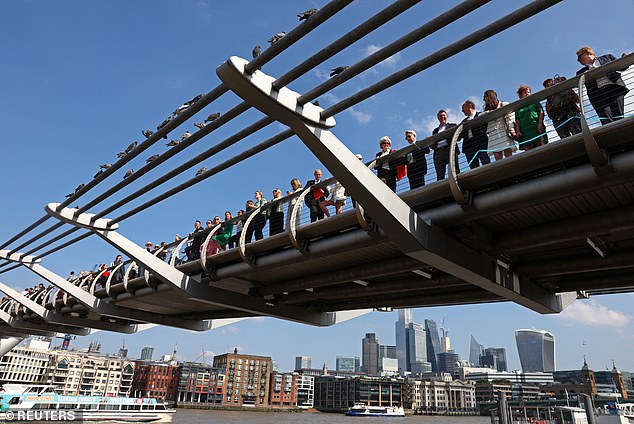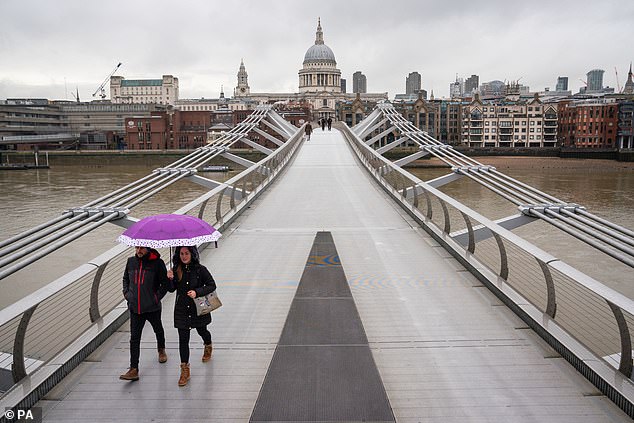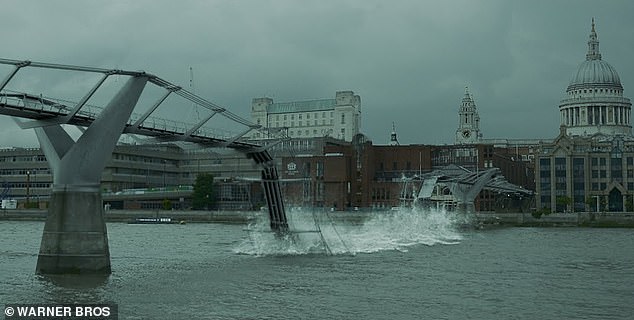Why is the Millennium Bridge swaying? Scientists explain the unusual phenomenon, as the famous London crossing is closed for urgent maintenance work
>
Since its opening more than 23 years ago, the Millennium Bridge has become one of London’s most famous landmarks.
But tourists hoping to cross the famous crossing in the coming weeks will be in for a disappointment.
It was announced this morning that the Millennium Bridge will be closed for three weeks for urgent maintenance work.
It has gained a bit of a reputation for being “wobbly”, famously wobbling under the weight of thousands of pedestrians when it first opened on 10 June 2000.
Here, MailOnline reveals the science behind this unusual phenomenon.

Since its opening in 2000, the Millennium Bridge has become one of London’s most famous landmarks. But tourists hoping to cross the famous crossing in the coming weeks will be in for a disappointment


It has gained some reputation for being ‘wobbly’, famously swaying under the weight of thousands of walkers when it first opened on 10 June 2000. Here, MailOnline reveals the science behind this unusual phenomenon
Before 2021, scientists thought the bridges oscillated because people fell into each other while walking, causing a synchronized pendulum effect.
But a study conducted that year rejected the so-called Kuramoto model, suggesting instead that bridges begin to sway when people walk at their own pace rather than imitating each other.
Once these oscillations begin, each person then tries to adjust their steps to prevent themselves from falling, which in turn destabilizes the bridge further.
The theory was put forward by researchers from Georgia State University.
“Think of passengers walking on a boat rocking side to side in a stormy sea,” said mathematician Igor Bilykh, of Georgia State University.
“They will adapt their movement horizontally and in the forward direction in response to the vibration of the boat.
“In particular, it will slow their forward movement.”
The transfer of energy from the steps to the bridge, and the oscillation it causes, is an example of negative damping, where small vibrations lead to much larger end results, the researchers said.
They used the example of a rusty seesaw on a playground and how it could eventually be made to move if it had enough people applying force to it.
The scientists used observations of various bridge swaying events, as well as modeling and other experiments to reach their conclusion.


The Millennium Bridge was used as a prime example supporting the Kuramoto model. This is because video analysis showed that the pedestrians’ heads and torsos move together as one
From the data they looked at, there was limited evidence that pedestrians were walking in sync with each other.
The Millennium Bridge was used as a prime example supporting the Kuramoto model.
This is because video analysis showed that the pedestrians’ heads and torsos move together as one.
“This explanation was very popular and part of the scientific zeitgeist,” Bilikh said.
However, Nobel laureate Brian Josephson was one of the first to question the synchronization explanation for the Millennium Bridge instability.
Another bridge swaying accident occurred in 2003.
A power outage on the East Coast of the United States caused several people to walk over the Brooklyn Bridge in New York, causing it to shake.
The walkers said they felt seasick and had difficulty maintaining their balance while standing.
The researchers in this study found that, in general, bridges are likely to be more susceptible to oscillations than previously thought.


The Millennium Bridge is famous for its appearance in the 2009 film Harry Potter and the Half-Blood Prince
Now they want to further analyze the movement of people in crowds to further support their theory that people’s naturally varying steps cause the bridges to sway, rather than synchronized walking.
They also said that in the future, engineers may be able to calculate the threshold before the bridge begins to sway based on the number of pedestrians walking across it.
For example, for the Millennium Bridge the number of people is about 165 people.
“Bridge designers must realize that there may always be serious cases of negative damping,” Bilikh said.
“Our formula provides useful estimates, given the expected number of pedestrians using the bridge.”
(tags for translation) Daily Mail
